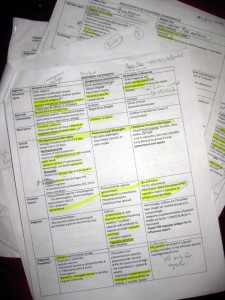Bugs And More Bugs

Parvo is a single dude, 19 years old, and a perv. He likes to get naked, and travel the globe for children to stalk. He likes to breathe on them and put lacey things on them. After the fifth incident, one of the kids’ mothers finds out, slaps Parvo on the cheek. Parvo gets mad and kills the babies.
In other words, B19 is a naked single-stranded DNA (“Dude”) virus belonging to the Parvoviridae family. It infects mainly children and causes a slapped-cheek rash on the face and lacy, maculopapular rash on the trunk and limbs of the body. It infects by binding to globoside (blood group P antigen) on erythroid precursors. It is spread through respiratory droplets (“breathing”). This disease is called Fifth Disease (Erythema Infectiosum). If mothers get infected, the virus can pass across the placenta, infecting and killing the fetus (hydrops fetalis). To diagnose, find IgM and IgG in the serology.
This and hundreds of more “bugs” are what we will be covering this semester in Medical Microbiology. For each bug, we will learn the species, family, infectious agent, reservoir, transmission, risk factors, virulence factors, clinical diseases they each cause, method of diagnosis, treatment, and prevention. In other words, it’s a lot of stuff to learn. How am I supposed to handle all this?
A good way to start is by making stories, and any med student would have a few good ones they use.
In my life, I’ve always loved doing things that would satisfy my drive to create: composing music, designing buildings, writing, drawing… In a way, I have found this opportunity in med micro. While it is one of the most intense classes I have taken so far in terms of rote memorization, it is a fun class because I can make up creative stories to try to let me remember all the details about the organisms and diseases. By the end of the semester, I’ll have lots of stories to tell you, and perhaps even more on Parvo later!
Here are the bugs we’ve covered so far:
Block 1:
- Measles Virus
- Rubella Virus
- B19 Virus
- Human Herpes Virus 6
- Streptococcus pyogenes
- Varicella-Zoster Virus
- Variola Virus
- Coxsackie A16 Virus
- Staphylococcus aureus
- Propionibacterium acnes
- Hemophilus influenza
- Streptococcus pneumoniae
- Neisseria gonorrhea
- Adenovirus
- Bacillus cereus
- Chlamydia trachomatis
- Pseudomonas aeruginosa
- Acanthamoeba castellani
- Aspergillus
- Fusarium
- Herpes Simplex Virus 1 and 2
- Loa loa
- Onchocerca volvulus
- Candida albicans
- Cytomegalovirus
- Toxoplasma gondii
Block 2
- Actinomyces israelii
- Pasteurella multocida
- Bartonella henselae
- Nocardia brasiliensis
- Streptobacillus moniliformis
- Eikenella corrodens
- Clostridium perfringens
- Vibrio vulnificus
- Francisella tularensis
- Leishmania
- Mycobacterium species
- Sporothrix schenckii
- Dracunculus medinesis
- Bacillus anthracis
- Orf virus
- Spirillum minus
- Human Papilloma Virus
- Molluscom contagiosum
- Microsporum
- Trichophyton
- Epidermophyton
- Malassezia furfur
- Salmonella species
- Trichinella spiralis
- Enterococcus faecalis
- Bacteroides fragilis
- Prevotella Melaninogenica
- Acinetobacter baumanii
- Neisseria meningitidis
- Streptococcus agalactiae
- Escherichia coli
- Listeria monocytogenes
- Cryptococcus neoformans
- Naegleria fowleri
- Togaviridae virus
- Flaviviridae virus
- Bunyaviridae virus
- Borrelia burgdoferi
- Rabies virus
- JC virus
- Polio virus
- Clostridium tetani
- Mycobacterium leprae
- Trypanosoma brucei species
- Echinococcus granulosus
- Taenia solium











